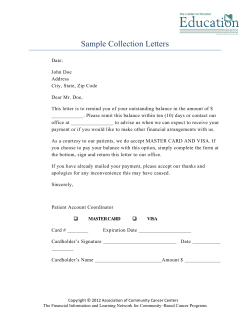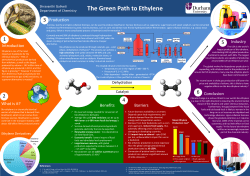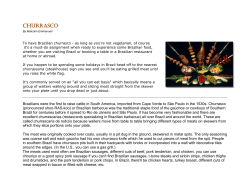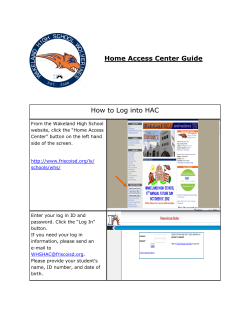
Document 210371
“The Brazil-US Biofuels Agreement: How to Move Forward” • Ethanol Summit • 2009 • Helena Chum • Research Fellow June 3, 2009 NREL is a national laboratory of the U.S. Department of Energy Office of Energy Efficiency and Renewable Energy operated by the Alliance for Sustainable Energy, LLC Multilateral Energy Cooperation U.S./Brazil U.S. – Brazil MOU to Advance Cooperation on Biofuels • Bilateral (DOE Lead, USDA) – Advancement of R&D of next generation biofuels technology • Multiple bilateral government visits – 2007 to present • Technical bilateral delegation visits – 2007 & 2008 • Specific collaboration identification – 2008 to present • Biofuels joint sustainability research – 2007 to present • Third Countries (DOS Lead, OAS/USTDA, UN Foundation, IDB) • Global (DOC/NIST and DOS Lead) Brazilian Delegation at NREL September 12, 2007 Back Row (L to R): Tom Foust*, Ron Benioff*, Helio Garbado Filho (Dedini), Luiz Joaquim Carvalho (Agriculture, Embrapa), Ricardo de Gusmao Dornelles (Ministry of Mines and Energy), Jaime Finguerut (CTC, Sugar cane and alcohol research center of São Paulo producers), Adriano Duarte Filho (MCT, Ministry of Science and Technology), Mauro Silva (Petrobras), Jonas Nolasco Jr. (Dedini, major plant manufacturer of the sugar cane and alcohol industry among others), Frederique Rosa e Abreu (Ministry of Agriculture, MAPA), John Ashworth*, Jim McMillan*, Jason Coughlin*. Front Row (L to R): Susan Hock*, Cindy Riley*, Wanderley de Souza (INMETRO, Brazilian standards organization), Helena Chum*, Ricardo Castello Branco (Petrobras), Elba Pinto da Silva Bon (Federal University of Rio de Janeiro, UFRJ), Alberto de Oliveira Fontes Jr (Petrobras), Ademar Ushima (IPT), Amy Chiang (DOE, Office of Energy Efficiency and Renewable Energy), Eduardo Caldas (Ministry of APEX), Jorge Almeida Guimaraes (CAPES), Paulo Soares (Dedini) * NREL Advance R&D of Next Generation Biofuels Technologies • Joint R&D areas identified by delegations 1. Advanced Biofuels Production – bio and thermal (DOE and USDA) 2. Systems Integration and Modeling – includes technoeconomic, LCA (DOE) 3. Biomass Production (USDA) • Research Cooperation Agreement – Petrobras and NREL signed October 2008; ongoing implementation DOE, NREL, ORNL, USDA-ARS, & Brazilian Hosts at Dedini Pilot Plant Whole cane harvester Usina da Pedra, Ribeirao Preto 4 Bilateral Sustainability Project • Part 1. Harmonization of GHG Measurements – Brazil sugarcane ethanol and bagasse power/ethanol – U.S. corn ethanol and future improvements – Comparison between the two countries • Part 2. Other Factors – Land Use Change – Metrics and Pilot Studies Bilateral Project Follows the Biomass Supply Chain on a Full Life Cycle Basis Brazil – MCT, CGEE, UNICAMP, ICONE, CBTE,USP (Piracicaba, Ribeirao Preto) US – DOE: NREL, ANL & ORNL, Univ. of Minnesota Export Meta analysis of existing data; GHG, air quality, water, land use, land use change, …from literature. What are the gaps in our knowledge? UNICA Collaboration on Land Use Change Brazil Sugarcane Ethanol Energy Balance and GHG Emissions August 2007-May 2009 1. Mutual Industry Benchmarking (44 mills Center South) 1. Compare GHG data with ANL’s GREET – 1/2008 PhD at UNICAMP Post Doc at NREL Joaquim Seabra 2. Scenarios for Industry Expansion to 2020 1. Electricity trash recovery (40%) & surplus power production with integrated commercial steam based cycle 2. Ethanol trash recovery and surplus biomass to produce ethanol from biochemical conversion in a projected system, integrated with the ethanol plant 3. Ethanol production using NREL Aspen Models for biochem and thermochem cellulosic ethanol processes colocated in one mill. Standalone or purchase of bagasse from one or two nearby mills cases investigated (11/08-5/09) Lifecycle Greenhouse Gas Emissions Associated with Different Feeds/Processes 19% 28% 1.3 % Reductions from Gasoline Energy Ratio Sugarcane Ethanol Bagasse 2006 Brazil Projected 52% Projected Projected 67 % 70% Projected 86% 5 12 Gasoline Petroleum U.S. Corn Ethanol Current Average U.S. U.S. Corn Stover Ethanol Natural Biomass Stover Gas for Process CHP & 2006 Heat Improvements No indirect land use change considered 2020 scenario 78% 9 12 Projected 120% Sugarcane & trash Ethanol &Electricity Brazil 2020 scenario Sources: Wang et al, Environ. Research Letters, May 2007; Wang et al, Life-Cycle Energy Use and GHG Implications of Brazilian Sugarcane Ethanol Simulated with GREET Model, 12/07 from data of Seabra, Macedo, Silva Biomass and Bioenergy (2008), doi:10.1016/j.biombioe.2007.12.006; NREL Sheehan et al. Journal of Industrial Ecology.(2003) Vol. 7(3-4), 2003; pp. 117-146; Tilman,Hill,Lehman, Science 314, 1598 (2006). Plevin and Mueller, Env. Res. Lett. 3, 2008, doi:10.1088/17489326/2/024003; , (S&T)2 Consultants Inc. (2009) An Examination of the Potential for Improving Carbon/Energy Balance of Bioethanol. IEA Bioenergy Task 39. T39TR1, 72 pp; http://www.task39.org/; De Kam, Tiffany, Morey, www.biomassCHPethanol.umn.edu. Sustainability Project Part 2 • Evaluate Direct and Indirect Land Use Changes – Three major economic models deal with land use change in the US: GTAP = Global Trade Analysis Project FASOM = Forest and Agricultural Sector Optimization Model FAPRI = Food and Agricultural Policy Research Institute/CARD FAPRI Brazil module was developed by Brazil’s ICONE – Collaboration with FASOM to produce a FASOM Brazil module by ICONE • Brazilian Collaborators Participate in DOE Activities – Contributions of ICONE and UNICA to the DOE Biomass Program Conference BIOMASS 2009: FUELING OUR FUTURE, March 17-18, 2009, National Harbor, MD – Contribution to DOE/ORNL Bioenergy and Land Use Change in Vonore, TN, May 2009 http://www.arb.ca.gov/fuels/lcfs/lcfs.htm, http://www.arb.ca.gov/regact/2009/lcfs09/lcfsisor1.pdf Brazilian scientists suggest indirect CI of 25 instead of 46 g CO2e/MJ based on GTAP model recalculation with ICONE’s current land use data and elasticity assumptions. 80% NG Feb 09 20% BM California Low Carbon Fuel Standards 10 Brazil Lower Bound Sugarcane Ethanol Brazil Proposed Value Brazil ARB Value US US US California Low Carbon Fuel Standards Feb 09 http://www.arb.ca.gov/fuels/lcfs/lcfs.htm, http://www.arb.ca.gov/regact/2009/lcfs09/lcfsisor1.pdf 11 Sustainability Project Part 2. • Jointly develop sustainability measures and metrics – Bilateral project meeting in June, Brazil to discuss status of project and write-up results – DOE, NREL, ORNL, and ANL in Brazil to define detailed scope of future years projects (September) • Future work - pilot studies – Integrated biorefineries in Brazil and US Acknowledgments U.S. Government – Department of Energy’s Office of the Biomass Program, Valerie Sarisky-Reed, Alison GossEng, Zia Haq, Paul Grabowski, Jacques Beaudry-Losique, Valri Lightner. http://www.eere.energy.gov/biomass U.S. Department of State NREL: Andy Aden, Abhijit Dutta, David Hsu, Dave Humbird, Ryan Davis, Danny Inman, Garvin Heath, Maggie Mann, Tom Foust, Rich Bain, Jim McMillan, Bob Baldwin, Ron Benioff ANL: Michael Wang, May Wu; ORNL: Keith Kline University of Minnesota, St Paul, Jason Hill, Doug Tiffany, Vance Morey Brazilian Government: MRE, Andre do Lago Ministry of Science and Technology, Adriano Duarte Filho CGEE, Marcelo Poppe Brazilian Researchers: UNICAMP: Isaias de Carvalho Macedo, Joaquim Seabra, Luiz Cortez CTBE: Marco Aurelio Lima, Arnaldo Walter ICONE: Andre Nassar. Leila Harfurch Visit us online at www.nrel.gov USP: Weber do Amaral, National Renewable Energy Angelo Gurgel UNICA: Joel Velasco Helena.Chum@nrel.gov Laboratory Innovation for Energy Operated forOur the U.S. Department of Energy Office of Energy Efficiency and Renewable Energy by the Alliance for Sustainable Energy Future .
© Copyright 2025





















